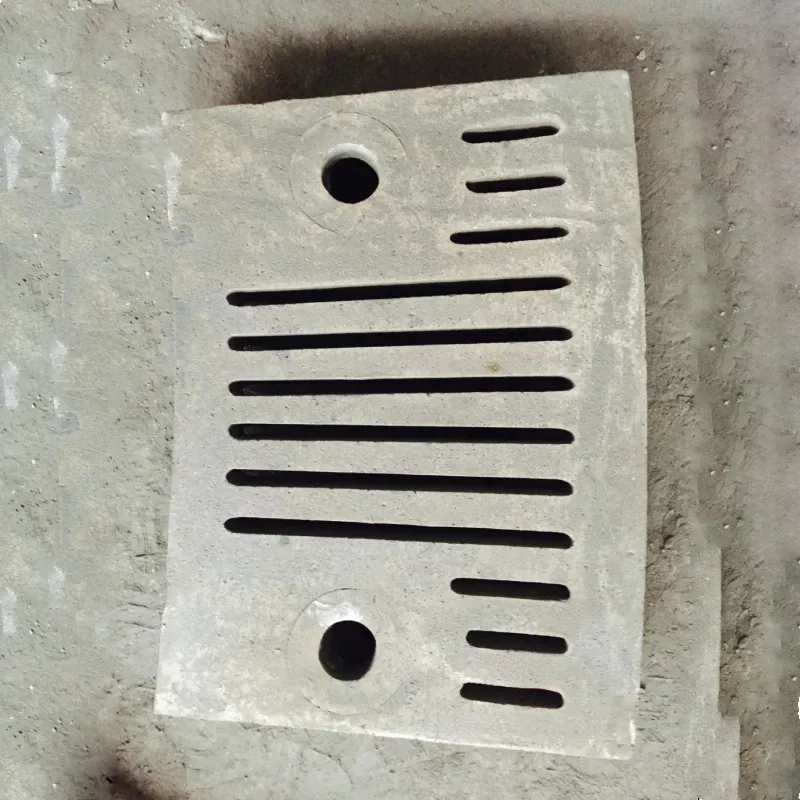Sep . 15, 2025 10:50 Back to list
High Manganese Steel Lining Plate- Shijiazhuang Chengda Wear Resistant Materials Co., Ltd.|Mill Liners&Ball Mill Liners
High manganese steel, also known as Hadfield steel, is a specialized alloy designed to withstand extreme mechanical stress. With a chemical composition of 10%-15% manganese and 0.90%-1.50% carbon, this material is celebrated for its exceptional strength, toughness, and wear resistance. Its unique properties make it a critical component in industries where equipment is subjected to severe impact and abrasion. This article explores the functionality, advantages, technical specifications, and real-world applications of high manganese steel lining plates, as well as the company behind this innovation: Shijiazhuang Chengda Wear Resistant Materials Co., Ltd..
Product Overview
High manganese steel lining plates, specifically sag mill liners, are engineered to endure harsh operating conditions. These components are used in heavy machinery such as ball mills and grate plates to protect equipment from wear caused by grinding and impact. The material's ability to harden on the surface while maintaining a tough core ensures long-term performance in environments like mining, metallurgy, and construction.

High manganese steel lining plates are designed to withstand extreme mechanical stress in industrial applications.

The unique properties of high manganese steel make it ideal for critical environments such as mining and metallurgy.
Key Features and Advantages
High manganese steel stands out due to its surface hardening capability. When subjected to impact or stress, the outer layer rapidly hardens, while the core remains tough. This dual property ensures that the material can absorb shocks without fracturing, making it ideal for high-impact environments. Additionally, after surface wear, the material undergoes secondary hardening, extending its service life.
- Exceptional Wear Resistance: Resists abrasion from grinding materials in industrial processes.
- Impact Absorption: Maintains structural integrity under severe mechanical stress.
- Longevity: Secondary hardening reduces the need for frequent replacements.
- Adaptability: Suitable for diverse applications, including mining, railways, and power generation.
Technical Specifications
| Parameter | Details |
|---|---|
| Chemical Composition | High manganese (10%-15%) and high carbon (0.90%-1.50%) |
| Hardness (Surface) | Typically 300-400 HB |
| Toughness (Core) | High ductility and impact resistance |
| Applications | Mining, metallurgy, construction, railways, power generation |
| Standards Compliance | Meets NIST guidelines for material testing and performance |
Applications in Critical Industries
High manganese steel lining plates are indispensable in industries where equipment is exposed to extreme conditions. For example:
- Mining: Used in sag mills and ball mills to grind ores and minerals.
- Metallurgy: Protects furnaces and reactors from abrasion during metal processing.
- Construction: Applied in heavy machinery like excavators and bulldozers.
- Railways: Enhances the durability of tracks and rolling stock.
- Power Generation: Used in turbines and generators to withstand mechanical stress.
The versatility of high manganese steel is further highlighted by its use in cutting-edge technologies. According to NIST research, materials with similar properties are being explored for applications such as magnetic levitation trains and rock drilling robots. This demonstrates the material's potential to adapt to future industrial demands.
Company Background: Shijiazhuang Chengda Wear Resistant Materials Co., Ltd.
Shijiazhuang Chengda Wear Resistant Materials Co., Ltd. is a leading manufacturer of high-performance wear-resistant materials. With decades of experience in the industry, the company specializes in developing solutions for harsh environments. Their products, including ball mill rubber lining and ball mill shell liners, are trusted by clients worldwide.
Shijiazhuang Chengda's commitment to innovation is evident in their ability to meet the evolving needs of industries. By leveraging advanced manufacturing techniques and adhering to international standards, the company ensures that its products deliver reliable performance. For more information about their ball mill liners for sale, visit their product page.
Why Choose High Manganese Steel?
The unique properties of high manganese steel make it a preferred choice over other materials. Unlike traditional alloys, which may fracture under impact, high manganese steel undergoes surface hardening to maintain durability. This makes it particularly effective in applications where impact loads and abrasion are prevalent.
According to NIST studies on material science, high manganese steel's ability to adapt to stress through secondary hardening sets it apart from conventional materials. This characteristic not only reduces maintenance costs but also enhances operational efficiency in industrial settings.
Conclusion
High manganese steel lining plates represent a significant advancement in industrial materials. Their combination of surface hardness and core toughness ensures long-term performance in demanding environments. Whether used in quarrying, mining, or power generation, these components play a vital role in maintaining equipment efficiency and safety.
For businesses seeking durable and reliable solutions, Shijiazhuang Chengda Wear Resistant Materials Co., Ltd. offers products that meet the highest standards of quality and performance. Explore their product range to discover how high manganese steel can benefit your operations.
References
NIST (National Institute of Standards and Technology) provides critical research and standards for material science and engineering. Their work ensures that materials like high manganese steel meet rigorous performance criteria. For further details, visit the NIST website.
-
Expert Insights on Fabrica de Molinos de Bolas: Industry Trends & Global Applications
NewsNov.24,2025
-
Expert Insights on Fabricantes de Bolas de Molienda de Acero: Global Applications & Trends
NewsNov.23,2025
-
Leading Fabricantes de Bolas de Molienda: Your Ultimate Guide to Grinding Balls
NewsNov.23,2025
-
Fabricante de Bolas de Molienda – Quality Grinding Balls for Efficient Industry
NewsNov.23,2025
-
Trusted Proveedores de Medios de Molienda for Efficient Industrial Grinding
NewsNov.22,2025
-
Proveedores de Bolas de Molienda: Your Guide to Top Grinding Ball Suppliers & Industry Insights
NewsNov.22,2025
Realted Products
















